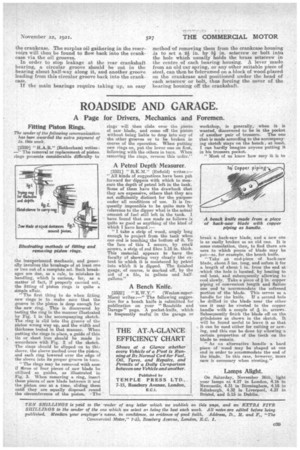ROADSIDE AND GARAGE.
Page 39

If you've noticed an error in this article please click here to report it so we can fix it.
A Page for Drivers, Mechanics and Foremen.
Fitting Piston Rings.
The sender of the following communication has bees awarded the extra payment of 5s. this week.
[2320] " H.A.B." (Rotherham) writes: The removal or replacement of piston rings presents considerable difficulty to the inexperienced mechanic, and geeerally involves the breakage of at least one or two out of .a complete set. Such breakages are due, as a rule, to mistakes in handling which is curious,for, as a matter Of fact, if properly carried out, the fitting of piston rings is quite a simple affair.
The first thing to do when fitting new rings as to make sure that the groove in the piston is deep enough for the new ring. This is discovered by testing the ring iii the manner illustrated by Fig_ 1 in the accompanying sketch. The ring is slid into the groove of the piston wrong way up, and the width and thickness tested in that manner. When putting the rings in place, a guide of thin tin or sheet iron should be made in accordance with Fig. 2 of the sketch. The rings should be slipped on to this sleeve, the sleeve Pushed over the piston. and each ring lowered over the edge of the sleeve into its proper groove in turn.
"The rings may be removed with ease if three or four pieces of saw blade be utilised as guides, as illustrated in Fig. 3. When removing a ring, insert these .pieces of saw blade between it and the piston one at a time, sliding, them until they are equally disposed round the circumference of the piston. • . The
rings will then slide over the pieces of saw blade, and COMO off the piston without being liable to drop into any of the other grooves or to be broken in course of the operation. When putting new rings on, put.the lower one on first, following with the others in turn. When removing the rings, reverse this order."
A Petrol' Depth' Measurer.
[2321] " R.K.M." Enfield) writes:— " All kinds of suggeations have been put forward for •dippera with which to measure the depth of petrol left in the tank. Seine of them have the drawback that they are expensive °there that they are net sufficiently distinct for the purpose under all conditions of use. It is frequently impossible to he quite sure by reference to the dipper what is the actual amount of fuel still left in the tank. I have found that. one made as follows is quite as good as anything el the kind of which I have heard:— " I take a strip of wood, amply long enough to project from the tank when one and is touching the bottom of it. Te the 'face of this I secure, by small nreWS, a strip of red fibre 1-16 in. thick. This material appears to have the faculty of showing very clearly the extent to which it is moistened by petrol into which it is dipped. The finished gauge, of course, is marked off, by the aid of a filet in gallons and halfgallons."
A Bench Knife.
[2322] " E.W.Y." (Weston-super Mare) writes :—" The following suggestion for a bench knife is submitted for publication on your " Roadside and Garage" page. A pocket-knife, which is frequently useful in -the garage or
THE AT-A-GLANCE EFFICIENCY CHART
Shows at a Glance whether even, Vehicle of a Fleet is Running at Its Normal Cost for Fuel, Oil, Tyres, and Repairs, and Permits of a Daily Comparison between one Vehicle and another.
Published by
TEMPLE PRESS LTD., 7-15, Rosebery Avenue, London,
E.C.1.
workshop, is generally, when it is wanted, discovered to be in the pocket of another pair of trousers. The one that is made according to the accompanying sketch stays on the bench; at, least., I can hardly imagine anyone putting it in his trousers pocket; "Most of us know how easy it is to break a hack-saw blade, and a new one is as easily broken as an old one. It is some consolation, then, to find there are uses to which pieces of blade may be put—as. for example, the bench knife.
" Take an end-piece of hack-saw blade, about 3 ins, long, and soften it for a length of about 1 in. from the end at -which the hole is located, by heating to red best, and subsequently allowing to cool slowly. Take a piece of in. copper piping of convenient length and flatten one end to accommodate the softened portion of the blade. This serves as a handle for the knife. If a second hole . be drilled in the blade near the other " one it may be riveted to the copper handle with a couple of 1%. in. screws. Subsequently finish the blade off on the grindstone as shown in the sketch. It will be found useful to leave it so that it can be used either for cutting or sawing, and this can he done by allowing a certain proportion of the teeth on the blade to remain.
" As an alternative handle a hard piece of wood may be shaped at one end in order to accommodate the end of the blade. In this case, however, more care is necessary when riveting."
Lamps Alight.
On Saturday, November 26th, light your lamps at 4.27 in London, 4.16 in Newcastle, 4.31 in Birmingham, 4.18 in Edinburgh, 4.32 in Liverpool, 4.37 in Bristol, and 5.15 in Dublin.








































